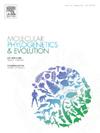用基因组学方法研究印度洋-太平洋海鹦(Anthozoa: Scleractinia)的巨型多样性。
IF 3.6
1区 生物学
Q2 BIOCHEMISTRY & MOLECULAR BIOLOGY
引用次数: 0
摘要
茯苓珊瑚是全球热带珊瑚礁生态系统的重要组成部分,是浅水珊瑚礁生态系统的工程师和生物多样性的枢纽。尽管波罗的海珊瑚具有重要的生态意义,而且被广泛用作研究模型,但该属物种的丰富性和进化关系仍然难以捉摸。在本研究中,我们基于缩减代表基因组学方法 ezRAD,分析了印度洋-太平洋地区 17 个地方的 330 个茯苓群落的基因组数据。我们检索了 25,163 个 SNPs,并为 29 个标称物种和 10 个未知形态提供了系统发生学假设,恢复了 15 个根深蒂固的分子支系。其中,12 个支系包括与单一不同形态物种相对应的样本。一个支系与任何标称物种都不匹配。其余两个支系由物种复合体组成,其中包括实验生物学中常用的各种块状和包壳形态。在这些复合体中,我们观察到了更多的地理或形态结构,表明了复杂的进化动态,可能反映了不同的物种、孤立的种群或杂交。此外,一系列不同的样本凸显了进行更多取样以确定物种边界和完善系统进化关系的重要性。我们还将研究结果与之前的系统发育数据集及其各自的采样地点相结合,对传统的海鲈物种地理分布观念提出了挑战。总之,我们的研究结果表明有必要修订过去的异名并正式建立新物种。要想有效地保护和管理珊瑚礁,就必须准确了解海茯苓的种类及其多样性和分布情况。本文章由计算机程序翻译,如有差异,请以英文原文为准。

A genomic approach to Porites (Anthozoa: Scleractinia) megadiversity from the Indo-Pacific
Porites corals are vital components of tropical reef ecosystems worldwide, serving as ecosystem engineers and hubs of biodiversity in shallow water coral reefs. Despite their ecological significance and the widespread use of Porites spp. as models for research, the richness and evolutionary relationships of species within the genus remain elusive. In this study, we analyzed genomic data from 330 colonies of Porites from 17 localities across the Indo-Pacific region based on the reduced representation genomic approach ezRAD. We retrieved 25,163 SNPs and provided a phylogenomic hypothesis for 29 nominal species and 10 unknown morphologies, recovering 15 deeply rooted molecular clades. Among these, 12 clades included samples corresponding to single distinct morphospecies. One did not match any nominal species. The remaining two clades comprised species complexes, which included various massive and encrusting morphologies commonly used in experimental biology. Within these complexes, we observed additional geographic or morphological structure, indicating complex evolutionary dynamics, possibly reflecting distinct species, isolated populations or hybridization. Additionally, a series of divergent samples underscored the importance of more sampling to define species boundaries and refine phylogenomic relationships. We also integrated our findings with previous phylogenetic datasets and their respective sampling localities, challenging traditional notions about Porites species geographic distributions. Overall, our findings indicate a need to revise past synonymies and to formally establish new species. A precise understanding of Porites species and their diversity and distributions is necessary for effective reef conservation and management.
求助全文
通过发布文献求助,成功后即可免费获取论文全文。
去求助
来源期刊
CiteScore
7.50
自引率
7.30%
发文量
249
审稿时长
7.5 months
期刊介绍:
Molecular Phylogenetics and Evolution is dedicated to bringing Darwin''s dream within grasp - to "have fairly true genealogical trees of each great kingdom of Nature." The journal provides a forum for molecular studies that advance our understanding of phylogeny and evolution, further the development of phylogenetically more accurate taxonomic classifications, and ultimately bring a unified classification for all the ramifying lines of life. Phylogeographic studies will be considered for publication if they offer EXCEPTIONAL theoretical or empirical advances.

 求助内容:
求助内容: 应助结果提醒方式:
应助结果提醒方式:


